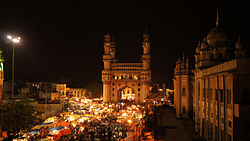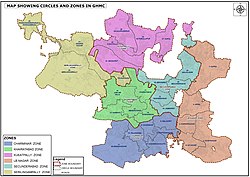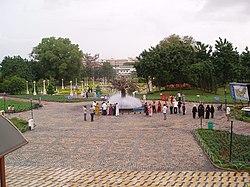Hyderabad, India
Hyderabad (pronounced (/ˈhaɪdərəbɑːd/ (![]() listen) HY-dər-ə-baad)) is the largest city and capital of the state of Telangana. At over 12.2[5] million, it has the largest population of any city in the state[6] Hyderabad is an A-1 city under the terms of development priorities.[7] It is also known as city of pearls[8] or city of Nizams.[9] The people of Hyderabad are called Hyderabadis.
listen) HY-dər-ə-baad)) is the largest city and capital of the state of Telangana. At over 12.2[5] million, it has the largest population of any city in the state[6] Hyderabad is an A-1 city under the terms of development priorities.[7] It is also known as city of pearls[8] or city of Nizams.[9] The people of Hyderabad are called Hyderabadis.
|
హైదరాబాదు हैदराबाद् حییدراباد | |
|---|---|
Nanakramguda skyline HITEC City Main Road | |
| Coordinates: Template:WikidataCoord | |
| Country | |
| State | Telangana |
| Districts | |
| Established | 1591 |
| Founded by | Muhammad Quli Qutb Shah |
| Named for | Caliph Ali Ibn Abi Talib |
| Government | |
| • Type | Municipal corporation |
| • Body | |
| • Parliament of India | Asaduddin Owaisi (AIMIM) G. Kishan Reddy (BJP) Konda Vishweshwar Reddy (BJP) Etela Rajender (BJP) |
| • Mayor | Gadwal Vijayalakshmi (INC) |
| Area | |
| • City | 650 km2 (250 sq mi) |
| • Urban | 1,225.59 km2 (473.20 sq mi) |
| • Metro | 7,257 km2 (2,802 sq mi) |
| Elevation | 536 m (1,759 ft) |
| Population (2011)[1] | |
| • City | 6,809,970 (4th) |
| • Estimate (2018)[2] | 9,482,000 |
| • Density | 10,477/km2 (27,140/sq mi) |
| • Urban | 7,677,018 (6th) |
| • Metro | 9.7 million (6th) |
| Time zone | UTC+5:30 (IST) |
| PIN(s) | 500xxx, 501xxx, 502xxx |
| Vehicle registration | TG-07 to TG-15 |
| Official languages | |
| International airport | Rajiv Gandhi International Airport (HYD) |
| Rapid transit | Hyderabad Metro |
| Website | www |
Hyderabad was founded in 1591 AD by Sultan Muhammad Quli Qutb Shah on the banks of river Musi. It was later ruled by the Mughal governor Nizam Asaf Jah I who then founded the Asaf Jahi Dynasty (Also known as The Nizams). There were a total of 10[10] Nizams with the last one being Osman Ali Khan, Asaf Jah VII.
The city is home to the Ramoji Film City which spans an area of over 2,000 acres (8.1 km2; 3.1 sq mi).[11] The movieindustry here is called The Hyderabad Deccan Urdu film industry (also known as Deccanwood).[12]
History
Archaeologists have found Iron Age sites in Hyderabad that are 2,500 years old.[13] These sites have been found near Haythnagar and Ramoji Film City,[14] and have burials and tools.[14] The Qutub Shahi kings ruled Hyderabad till 1687 when the city was taken over by the Mughals. Muhammad Quli Qutub Shah was a Qutub Shahi ruler who ordered the construction of the Charminar as a mosque.[15] Nawab Abdul Hassan Shah who is popularly known as Tanisha was the last Qutub Shahi ruler of Hyderabad before Aurangzeb captured it in 1687.[16] Asaf Jah was declared the governor of Hyderabad by Aurangzeb.[17] This is how the Asaf Jahi Dynasty began which ruled Hyderabad till 1948.[18]
Hyderabad became a princely state in 1947 after the collaboration with India. But soon the Nizam had to sign an Instrument of Accession to the Union of India so that Hyderabad becomes a part of India.[19] On 1 November 1956, the province of Hyderabad was divided into Karnataka, Maharashtra and Andhra Pradesh on the basis of language. So, Hyderabad came into the Telugu speaking community and thus became the capital of Andhra Pradesh.[20] The state of Telangana was formed on 2 June 2014 and separated from Andhra Pradesh retaining Hyderabad as it's capital.
The city has now developed in fields of IT with four IT universities including JNTU (Jawaharlal Nehru's Technological University ).[21] The rise of International Airport and real estate has a major impact on the development of Hyderabad.[22]
Geography
Hyderabad is situated at the Deccan Plateau, 500 meters above the sea level[23] and most of the area is rocky.[24] Paddy is the main crop grown and other crops include Bengal gram, groundnut, sugar cane and sunflower. Hyderabad was found on the banks of Musi river in 1591. Today that area is known as old city where Mecca Masjid and Hussain Sagar Lake exist.[25] The area has many official buildings and that area is very old.[26] From the recent time, Hyderabad has been merged with Secunderabad. This has led a large, united and populous city with many villages surrounding it.[27]
Climate
Hyderabad has a hot, wet and dry climate. The monsoon or rainy season is from late June until late October.[28][29][30] On average, 32 inches of rain falls on the city each year. The highest temperature ever recorded was 51.5 °C (113.9 °F) on 2 June 1966. The lowest recorded temperature was 1.1 °C (43 °F) on 8 January 1946.[31][32] It is cooler in the evenings and mornings because the city is high above sea level.[32]
Population
The city has a population of over four million.[33] Hindus form the majority[34] while Muslims are 40% of the population. The Muslim community of Hyderabad is largest in Telangana.[35] Christians are also in a considerable numbers in the city. Famous churches include those around Abids and Secunderabad like St. Joseph's Cathedral.[36]
Culture
Architecture
Charminar is actually founded as a Mosque and later by archaeological department changed into a monument. Charminar has long been the icon of Hyderabad. The name means "Four minarets". The towers rise to a height of 48.7 m above the ground. There is a mosque with 45 prayer spaces in the upper storeys of the building.
The Golconda Fort was the capital of the Qutb Shahi kingdom. In the 16th century, it was the center of a busy diamond trade. The outer wall of the fort is 10 km around.
Mecca Masjid is one of the oldest mosques in the city. Muhammed Quli Qutub Shah began building it in 1617. Mughal emperor Aurangzeb finished the building in 1694. The mosque is made of granite. The main hall of the mosque is 75 feet high, 220 feet wide and 180 feet long. Ten thousand worshippers can fit inside at the same time. The entrance arches are made of single slabs of granite. It is believed that Muhammed Quli had bricks made from earth brought from Mecca. He used them the central arch of the mosque. This explains the name of the mosque.
The Chowmahalla Palace was Asaf Jahi dynasty capital. The Nizam entertained official guests and royal visitors here.
Nawab Viqar al-Umra built Falaknuma Palace in 1872. The palace includes sculptures by artists from Florence.
Language
Telugu, Urdu and Hindi are mainly spoken in Hyderabad.[37][38][39] English is also spoken among the educated people. The Telugu dialect spoken across Telangana is very different from the one in the Andhra Pradesh Region.[39]
Hyderabad, India Media
A 17th century Deccani School miniature of Qutb Shahi ruler Abul Hasan Qutb Shah with Sufi singers in the Mehfil-("gathering to entertain or praise someone").
A picture of a doubledecker bus in Hyderabad in the 1940s. Bus services were introduced in Hyderabad by 1932
A satellite view of Hyderabad captured by Sentinel-2A, the yellow and brown colours feature the city core, the light green shows arid fields and the dark green depicts vegetation. The Musi River and its adjacent small water bodies are highlighted with a blue colour.
The NTR Gardens is among the gardens in the vicinity of Hussain Sagar lake serving as a recreation park.
Optimist and Laser dinghies during the Hyderabad Sailing Week regatta at Hussain Sagar
Related pages
References
- ↑ Cite error: Invalid
<ref>tag; no text was provided for refs namedgreater Hyderabad. - ↑ "The World's Cities in 2018" (PDF). United Nations Department of Economic and Social Affairs. 2018. Archived (PDF) from the original on 15 March 2021. Retrieved 11 July 2020.
- ↑ Cite error: Invalid
<ref>tag; no text was provided for refs named2011UA. - ↑ Time to put metropolitan planning committee in place. Hyderabad. 28 July 2014. https://timesofindia.indiatimes.com/city/hyderabad/Time-to-put-metropolitan-planning-committee-in-place/articleshow/39138115.cms. Retrieved 22 March 2016.
- ↑ "Hyderabad Population 2019- Current Population of Hyderabad City". www.indiaonlinepages.com. Retrieved 18 February 2020.
- ↑ http://www.censusindia.gov.in/2011-prov-results/paper2/data_files/India2/Table_2_PR_Cities_1Lakh_and_Above.pdf
- ↑ Anand, Sarthak (11 September 2009), "Fit to be a capital", The Times of India:Student Edition, p. 2
- ↑ Watson, Patrick (1 June 2007), High times in Hyderabad, PerthNow, archived from the original on 5 August 2007, retrieved 7 September 2009
- ↑ Sarathy, Partha (8 January 2009), "Satyam: true lies", Indian Express, retrieved 7 September 2009
- ↑ "Asaf Jahi Dynasty - Family of the Nizams of Hyderabad (1724 - 1948)". HyderabadPlanet.com. Archived from the original on 31 December 2011. Retrieved 18 February 2020.
- ↑ "Ramoji Film City - India's Only Thematic Holiday Destination". www.ramojifilmcity.com. Retrieved 18 February 2020.
- ↑ Mumtaz, Roase. "Deccanwood: An Indian film industry taking on Bollywood". www.aljazeera.com. Retrieved 18 February 2020.
- ↑ May 18, Siddharth Tadepalli | TNN | Updated; 2015; Ist, 19:34 (18 May 2015) (in en). Rare discovery pushes back Iron Age in India | Hyderabad News - Times of India. https://timesofindia.indiatimes.com/city/hyderabad/Rare-discovery-pushes-back-Iron-Age-in-India/articleshow/47322021.cms. Retrieved 2020-02-18.
- ↑ 14.0 14.1 "Hyderabad's history could date back to 500 BC", The Economic Times, 10 September 2008, retrieved 9 September 2009
- ↑ "Charminar's location still has historians stumped", The Times of India, 16 September 2001, retrieved 9 September 2009
- ↑ "On the banks of the Godavari", The Hindu, 14 November 2004, archived from the original on 4 October 2008, retrieved 9 September 2009
- ↑ Richards, J. F. (1975), "The Hyderabad Karnatik, 1687–1707", Modern Asian Studies, 9 (2): 241–260, doi:10.1017/S0026749X00004996, S2CID 142989123
- ↑ Sivanandan, T.V. (17 September 2004), "The exit of an infamous ruler", The Hindu, archived from the original on 5 October 2008, retrieved 9 September 2009
- ↑ Noorani, A.G., "A tale of two states", THE HINDU, archived from the original on 27 March 2008, retrieved 12 September 2009
- ↑ History, archived from the original on 21 September 2010, retrieved 9 September 2009
- ↑ Information Technology Colleges in Hyderabad, India Career, archived from the original on 17 July 2009, retrieved 10 September 2009
- ↑ Updated Election Results Details of Hyderabad, India Elections.co.in, archived from the original on 20 August 2009, retrieved 10 September 2009
- ↑ Laxmaiah, Avula (2007), "Factors Affecting Prevalence of Overweight Among 12- to 17-year-old Urban Adolescents in Hyderabad, India", Obesity, 15 (6): 1384–1390, doi:10.1038/oby.2007.165, PMID 17557974, S2CID 30530158, retrieved 11 September 2009
- ↑ Burte, Himanshu (11 December 2008), Public spaces for children: Too few to count, retrieved 11 September 2009
- ↑ Jafri, Syed Amin (18 May 2007), We thought it was a tyre burst, Rediff News, retrieved 11 September 2009
- ↑ Ramachandran, Sudha (7 September 2007), "The dark side of Hyderabad's success", Asian Times, archived from the original on 15 December 2009, retrieved 11 September 2009
- ↑ "Hyderabad's fate hangs in balance", Times of India, 10 October 2008, retrieved 11 September 2009
- ↑ "Hyderabad monsoon races from 18 July", The Hindu, 9 June 2005, archived from the original on 11 February 2009, retrieved 12 September 2009
- ↑ "Hyderabad Monsoon season from 19 July", The Hindu, 29 May 2007, archived from the original on 21 April 2008, retrieved 12 September 2009
- ↑ "Hyderabad monsoon season from 19 July", The Hindu, 19 June 2004, retrieved 12 September 2009[dead link]
- ↑ "Severe heat wave in AP continues", The Indian Express, 31 May 1997, retrieved 12 September 2009[dead link]
- ↑ 32.0 32.1 Weatherbase: Historical weather for Hyderabad, India, retrieved 12 September 2009
- ↑ India: largest cities and towns and statistics of their population, World Gazetteer, archived from the original on 17 November 2006, retrieved 12 September 2009
- ↑ Boda, Sharon La (1995). International Dictionary of Historic Places: Asia and Oceania. Taylor & Francis. p. 370. ISBN 978-1-884964-04-6.
- ↑ Khan, Masood Ali (1 August 2004), "Muslim population in AP", The Milli Gazette, retrieved 12 September 2009
- ↑ Hyderabad's Temples, Mosques and Churches, HyderabadOnline.in, archived from the original on 16 March 2010, retrieved 12 September 2009
- ↑ "BACK TO ROOTS: Cultural troupes lend an air of festivity to the Andhra Telugu Association celebrations in Hyderabad", The Hindu, 25 December 2005, archived from the original on 29 December 2007, retrieved 3 October 2009
- ↑ "Quota for Muslims at all-India level favoured", The Hindu, 31 July 2007, archived from the original on 6 October 2008, retrieved 3 October 2009
- ↑ 39.0 39.1 Maloney, Clarence (1978). Language and civilization change in South Asia. Brill Archive. p. 182. ISBN 978-90-04-05741-8.

















